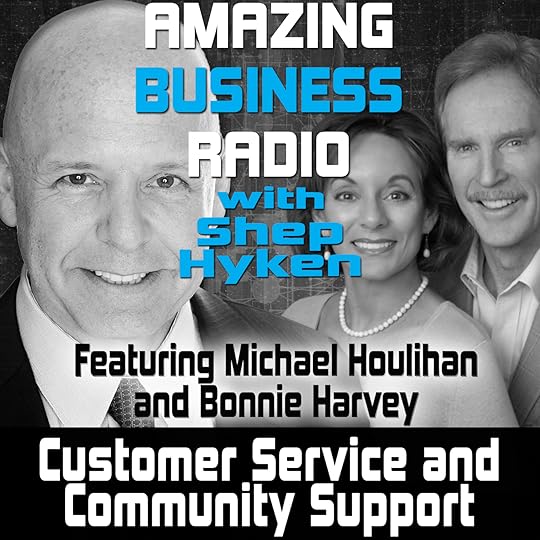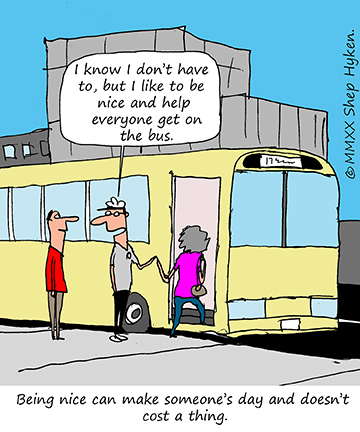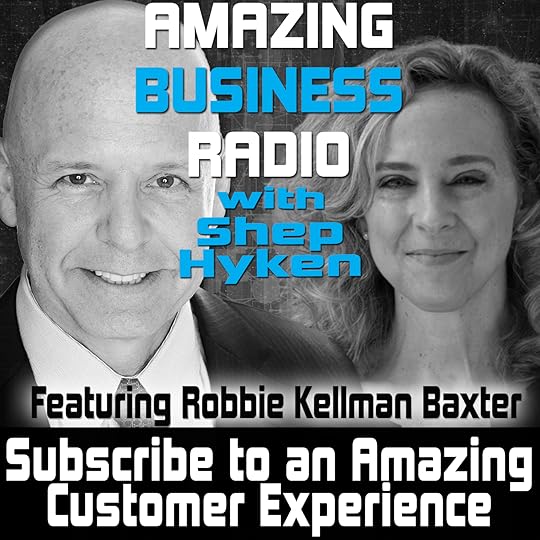Shep Hyken's Blog, page 100
August 24, 2020
5 Top Customer Service Articles For the Week of August 24, 2020
Each week I read a number of customer service and customer experience articles from various resources. Here are my top five picks from last week. I have added my comment about each article and would like to hear what you think too.
Can Artificial Intelligence Improve Your Customer Service? by Mitul Makadia
(Business2Community) By transforming customer service interactions, AI-powered digital solutions are prepared to improve every aspect of your business including online customer experience, loyalty, brand reputation, preventive assistance, and even generation of revenue streams.
My Comment: There is a lot written about chatbots and AI (Artificial Intelligence). I have seen incredible strides over the past few years as these technologies improve. The question is, do they really improve your customer service? This article has plenty of information to make the case. As you read this, keep in mind, you must maintain the balance between what you do in the digital world and how you connect in the human-to-human world.
13 Actionable Tips to Attract More Clients to Your Law Firm by Jacob Maslow
(LegalScoops) Here are actionable tips that can be employed to successfully maintain and grow client relationships, which results in a profitable customer base for your law firm.
My Comment: Just because this article is about attracting clients to a law firm, don’t think you can’t learn from it. Any – or maybe even all – of the ideas are appropriate for most businesses. You can call them clients, customers, patients, guests, members, etc. You want more of them, then read this article. And, for many of these ideas, you won’t need much of a budget. It’s just doing the work.
The 6 Pillars to Create a Positive Digital Customer Experience (dCX) by Andre Havro
(Business2Community) With a global crisis forcing many companies to close or operate at reduced capacity, it may be surprising to learn that consumers expect service to remain unchanged. It is apparent people want to feel seen, recognized, and appreciated by the companies they choose to support.
My Comment: The article starts with a comment that in spite of the global crisis that has forced change on many businesses, customers still expect customer service to remain unchanged. That’s an intriguing statement that is then supported with six “pillars” (actually strategies and tactics) to help you and your organization deliver a better digital experience.
What’s the difference between CX and UX? by Qualtrics
(Qualtrics) The terms CX and UX are often confused or used interchangeably. Here we define each one and explain the differences between them.
My Comment: Is there a difference between CX and UX? Of course, there is, and this article will not only point out the differences but also give you some actionable ideas and best practices. I like articles with bullet points. They are typically short and concise nuggets of information. There are plenty of them here. Eighteen to be exact.
5 Ways To Elevate Employee Satisfaction That Boost Customer Satisfaction by Anjan Pathak
(CustomerThink) Customer wellbeing has become the most crucial factor to consider when you want your business to grow. To achieve this feat, it’s vital to account for your employee’s satisfaction, who deals with customers directly or indirectly.
My Comment: If you want a good customer experience, then take a look at the inside of your business or organization at the employee experience. That’s where it starts. While there are a number of ideas, pay attention to number three, which is about conducting employee feedback sessions. Many companies focus on getting feedback from their customers. It’s just as important to know how you’re doing with employees. Remember, what’s happening on the inside of an organization is felt on the outside by their customers.
BONUS
Top Eleven CX Contact Center Influencers You Need to Follow by Anna Tsymbalist
(shelf) Since these folks have been so helpful sharing advice and best practices, we compiled a list of the top ten contact center and customer experience influencers we think you should follow. We think you’ll appreciate the latest insights and valuable advice they regularly share with their followers.
My Comment: I’m honored to be recognized as one of the top customer experience contact center influencers. And, this is a very impressive list of thought leaders and executives. Thank you to Shelf.io for this great surprise!
 Shep Hyken is a customer service expert, professional speaker and New York Times bestselling business author. For information on The Customer Focus™ customer service training programs go to www.TheCustomerFocus.com. Follow on Twitter: @Hyken
Shep Hyken is a customer service expert, professional speaker and New York Times bestselling business author. For information on The Customer Focus™ customer service training programs go to www.TheCustomerFocus.com. Follow on Twitter: @Hyken
The post 5 Top Customer Service Articles For the Week of August 24, 2020 appeared first on Shep Hyken.
August 21, 2020
Guest Post: How to Enhance Customer Experience Through Change
This week we feature an article by Ricardo Saltz Gulko, managing director and co-founder of Eglobalis . He shares 5 habits of companies that went through dramatic transformation and still managed to improve the customer experience.
Over the last few months, most businesses have had the opportunity to reconsider processes, products, and people. For some, it has been a monumental and frustrating struggle, while others have been able to plan and execute deep changes that have improved adoption, satisfaction, safety, and (most likely) loyalty and growth for years to come.
No one wants global events like this nightmare pandemic to occur in the first place, much less ever again. However, the struggle to adapt over the last few months has created a new urgency to reimagine business models so that they become more capable of change.
Fortunately, there is no mystery to it. We have precedent in most industries and in some of the world’s largest corporations. These successful transformation initiatives have built a strong case for a few organizational qualities shared by simplified, flexible, adaptive businesses.
5 Habits of Companies that Improve Customer Experience Through Change
Prioritize human needs (customers, partners and employees).
In the past, the motivation was more value, better experiences, and revenue generation. Now, this old model is showing its age in many industries! Employees, partners, and customers expect more from the organizations they support and interact with. Measuring value in terms of value-added to your humans including partners, customers and employees is no longer a radical experiment; it actually motivates organizations to adapt more quickly, create products and services that humans are eager to adopt, and as a consequence, grow. One nice example is the simple case of digital transformation.
Accept that change is every day from now forward.
Digital transformation (in fact any kind of transformation) is not a matter of a project or a limited time period. It is a continuous force that continues even if life were to suddenly stay the same. After we overcome the pandemic, there will be something else — with a different buzzword but also requiring us to transform, simplify, adapt, disrupt and comply.
Transformational programs do not have an end date. The challenge lies in understanding today’s changing reality and employees and customer insights and needs, so that you can equip your people with the right skills and tools. It will require continuous onboarding and ongoing training, as well as good communication of the vision with customers, partners and employees, so that people align, collaborate and evolve together. Nothing is static, thankfully.
Revise culture starting with the C-Suite.
Adaptation is often required at every level in order to align the organization with external change. Thus, every level of the organization, from C-Suite down, needs to be practicing a continuous regimen of adaptation. Bring implementation and how to execute it together into the discussion. Question, challenge the complexities efficiencies and evaluate how the group achieves its objectives. Follow through with practical implementable proposals. Gather feedback and re-evaluate. When this cycle is practiced at every level, change becomes commonplace in every corner of your organization.
Hire adaptive people, and don’t just “empower” them; give them real power.
You need talent to develop the right kind of experience in order to instigate adoption and deliver a great customer experience. The more prepared and highly skilled your talent is, the easier it will be for them to:
Process new information
Adopt new behaviors
Adapt technologies for human needs and collaborate
Design better solutions to intuitively instigate adoption
The caveat here is, in order to capitalize on that talent, you need to give teams real decision-making power and freedom to create. Structure teams (as agile processes often do) in multicultural, diverse and inclusive groups. This ‘’still modern’’ governance structure has been shown to outperform traditional models frequently in organizations of every size and industry, including Microsoft, SAP, Spotify and others, often leading to better interactions, creative output, practical ideas, collaboration, loyalty, and trust, ultimately delivering real innovation, simplified human experience and growth.
Let simplification and sense of simplicity generate innovative ideas.
What you are really looking for is not a set of tasks anymore but for people to use their free minds to imagine better ways to do things. Easier said than done, I must admit, but very possible for any company. As the groups comprising your organization explore new ways to function, it will help to set simplicity as an aim and magnetizing force. Simplicity makes it easier to create, to explore ideas and to solve issues objectively. Simplification does not happen overnight but helps organizations change more quickly when prioritized at every level of activity.
Now You Are Ready to Respond to Change and Challenges
Some of the above habits, such as simplification and adaptive culture models, will likely require time to start seeing improvements. Others, such as the prioritization of humans should start now. If you have not already, start to address needed changes. Use these first examples as opportunities to observe how your model works or does not work. Evaluate outcomes; change the platform of status quo and consensus mindset; and develop the right skills to execute on your future.
The next version of your business will have different abilities, practices and capabilities. But most importantly, you will have developed real experience with transformative power and continues ability to generate adoption, simplicity and growth.
Ricardo Saltz Gulko is the Eglobalis managing director, a global strategist, thought leader, CX practitioner, and keynote speaker in the areas of simplification and change, customer experience, experience design, and global professional services. He currently works with tech global companies aiming to transform themselves around simplification models, culture and digital transformation, customer and employee experience. You can learn more about him, his passions, and his charitable causes at his LinkedIn, Facebook, or Twitter.
F
 or more articles from Shep Hyken and his guest contributors go to customerserviceblog.com.
or more articles from Shep Hyken and his guest contributors go to customerserviceblog.com.
Read Shep’s latest Forbes article: The Top Ten Companies In The US
The post Guest Post: How to Enhance Customer Experience Through Change appeared first on Shep Hyken.
August 19, 2020
Be a Professional
 What is a professional? Is it the opposite of an amateur?
What is a professional? Is it the opposite of an amateur?
In the sports world, professional athletes are paid, while amateurs are not. In my business, the title “professional keynote speaker” implies that I’m paid to speak in front of audiences. So, does being a professional simply mean you’re paid to do whatever it is you are doing?
I’ll answer that with a resounding, “No!” It’s definitely more than whether or not you are paid. I’ll argue that “professional” can also refer to the way you conduct yourself. In other words, do you behave in a manner that others would perceive as professional?
My friend Paul Reilly, a professional speaker (yep… another paid professional) specializing in value-added selling, shared a great story. As one of his first jobs out of college, Paul worked at Ferrellgas. One of his colleagues was writing a summary report and was using a dictionary to look up words. Paul was fascinated that this man would take time to look up words for what was considered an informal report. When Paul asked about it, his colleague said, “It may be informal, but that doesn’t mean it shouldn’t be professional.” His idea of taking the report to a professional level was to have no misspellings.
I read an article penned by Dale Salwak in Linking Ring Magazine, the publication put out by the International Brotherhood of Magicians. By the way, these magicians focus on entertainment rather than voodoo or witchcraft, in case you were concerned. Dale is a magician—yes, a professional magician—and one of the best. He learned from Neil Foster, another professional magician who was an amazing performer and an inspiring teacher. Neil had a great definition of being a professional: “A professional just is, that’s all. He or she knows what they are going to do, and they do just that.” Neil goes on to say that a professional performance is always predictable.
After doing a little research about being professional, I’ve come to the conclusion that it’s not about whether you are paid or not—it’s about your behavior. In my world of customer service, it’s about how you act toward and treat others. It’s about the empathy and compassion you have around your customers’ needs. It’s about how you respect those customers and, for that matter, your colleagues.
Professionals at every level and in any profession can behave and act appropriately. That’s what makes their customers, colleagues and team members want to work with them. Being professional earns you respect. It builds trust. It creates a connection.
The best don’t just act professional. They are professional.
Shep Hyken is a customer service expert, keynote speaker, and New York Times bestselling business author. For information, contact 314-692-2200 or www.hyken.com. For information on The Customer Focus™ customer service training programs, go to www.thecustomerfocus.com. Follow on Twitter: @Hyken
(Copyright © MMXX, Shep Hyken)
The post Be a Professional appeared first on Shep Hyken.
August 18, 2020
Amazing Business Radio: Michael Houlihan and Bonnie Harvey

Customer Service and Community Support
How to Use Customer Experience as a Brand Identity
Shep Hyken interviews Michael Houlihan and Bonnie Harvey, founders of Barefoot Wine. They discuss how Michael and Bonnie built a successful wine business from the ground up by focusing on customer service and experience.








Top Takeaways:
Creating a good customer experience requires doing research. Learn about your customers and their expectations, then build your CX to meet those expectations.
To find out what your customers want, ask them! Incorporate conversations with customers into your business and CX model. Ask people who may not usually get asked. There are many untapped sources of valuable information that will help you succeed.
Know who your customers are, and once you do, you will be able to better market to them personally. Personalization will help your product sell.
Don’t confine yourself to your industry alone. Mine information from other industries. This will help you come up with more creative solutions to problems.
When you support your community, they will support you. The more you give, the more you get. This is the law of reciprocity.
Everybody is in customer service whether they realize it or not. Even if an employee doesn’t have direct contact with a customer, they support someone who does. Customer service must be part of the company’s culture.
Employees who do come into direct contact with customers are best positioned to collect customer feedback. This feedback must be communicated throughout the rest of the organization.
A great product or service alone is not enough to get and keep customers. You must support your great product/service with amazing customer service.
Don’t just be a vendor; be a partner. This means helping your clients and customers succeed with the product or service you offer. This goes beyond customer service and into customer support and customer success.
Quotes:
“Make friends in low places. Ask questions and gather information from everyone. It’s amazing what you’ll learn about your customers and their expectations.”
“Your customers buy YOU. They don’t buy your product. The question is, can they depend on you to service what you sell? Do you really satisfy the customer service that they want?”
“Try not to fall in love with your product or service. Don’t think that there’s a value to your product or service that overpowers the need for detailed customer service research.”
About:
Michael Houlihan and Bonnie Harvey are the founders of Barefoot Wine and Business Audio Theatre. They are the New York Times bestselling authors of The Barefoot Spirit: How Hardship, Hustle, and Heart Built America’s #1 Wine Brand.
Shep Hyken is a customer service and experience expert, New York Times bestselling author, award-winning keynote speaker, and your host of Amazing Business Radio.
The post Amazing Business Radio: Michael Houlihan and Bonnie Harvey appeared first on Shep Hyken.
August 17, 2020
5 Top Customer Service Articles For the Week of August 17, 2020
Each week I read a number of customer service and customer experience articles from various resources. Here are my top five picks from last week. I have added my comment about each article and would like to hear what you think too.
Customer Experience Emerges As A Critical Strategy For Small And Medium Sized Businesses by Maria Morais
(Forbes) In its report, “Digital, Resilient, and Experience-Driven,” the global economic consultancy and thought leadership firm found that 53% of top performers – companies with the strongest revenue growth and profit-margin change – consider the quality of their customer experience as their top strategic priority for the next three years.
My Comment: What happens when you combine a good product that is competitively priced and the experience is easy? A winning combination that gets your customers to want to come back. While the title of the article states this is a sound strategy for small and medium-sized businesses, the larger businesses should take note. Price may become less sensitive for larger B2B’s, but product reliability and convenience are non-negotiable.
What COVID-19 Did to Customer Loyalty by Caroline Jansen
(Retail Dive) As retailers grappled with out-of-stocks, research found that 75% of consumers opted to shop alternative brands.
My Comment: Our customers may have changed their buying habits in the past five months since the COVID-19 wreaked havoc on the business word. How does that impact their loyalty to us? Here are a few ideas with commentary from some industry thought leaders CX executives.
21 Powerful Ways To Build Brand Loyalty by ShoppingGives
(ShoppingGives) Brand loyalty can increase your company’s overall revenue, make better use of marketer investments, and insulate your company against changes in the economy.
My Comment: Another list of experts weighing in on how to create brand loyalty. This time there are 21 and it includes an A to Z list of the industry of experts and thought leaders, starting with Adam Toporek and ending with Zsuzsa Kecsmar.
Key to retailers’ success post-COVID-19: 4 necessary customer experience practices by Kelly Ungerman
(Retail Customer Experience) This article shares four customer experience practices that can frame short-term responses, build resilience, and prepare retailers for success in the days after COVID-19.
My Comment: In the recent Consumer Sentiment survey conducted by McKinsey & Company, only a third of U.S. consumers are optimistic about an economic recovery in the next two to three months. Most believe it will be more than six months. In addition, consumers are spending less money. This is a result of COVID-19, and as businesses are re-opening and figuring out how to operate post-COVID, there are a few suggestions here to consider.
Service operations: the critical piece to amazing customer service by Paul Selby
(CustomerThink) When customers pick up the telephone or chat online to engage live with customer service, it’s with an agent: a frontline customer service person. Any customer service leader will tell you having a friendly and well-trained staff is critical to delivering great customer service, and they are correct. Except there’s more to customer service than just a helpful voice.
My Comment: There is a definition of customer service that says customer service is what happens when customer experience fails. In other words, you pick up and call the customer service or support department. Yes, that’s one aspect of it, but Paul Selby takes a deeper look into what drives service operations that can help deliver an amazing customer service experience.
BONUS
How to create a great customer experience strategy in 6 steps by Albert McKeon
(Tech Target) In today’s business landscape, a powerful CX strategy is key to gaining customer loyalty and a competitive advantage. Here’s how to deliver a great customer experience, plus a template.
My Comment: If you’ve been following these recaps, you know I love lists. Sometimes they are just reminders. Other times there are one or two (or more) ideas. Here’s a nice list that includes commentary from a few of my customer service and experience friends (and they included my thoughts as well). A short read, but a good one!How to create a great customer experience strategy in 6 steps.
 Shep Hyken is a customer service expert, professional speaker and New York Times bestselling business author. For information on The Customer Focus™ customer service training programs go to www.TheCustomerFocus.com. Follow on Twitter: @Hyken
Shep Hyken is a customer service expert, professional speaker and New York Times bestselling business author. For information on The Customer Focus™ customer service training programs go to www.TheCustomerFocus.com. Follow on Twitter: @Hyken
The post 5 Top Customer Service Articles For the Week of August 17, 2020 appeared first on Shep Hyken.
August 14, 2020
Guest Post: 5 Inevitable Tips That Can Ensure a Superb Customer Experience
This week we feature an article by Rakshit Hirapara , a content marketer at PeddleWeb. He writes about the importance of ensuring a positive customer experience, especially during a world crisis.
The customer experience (also referred to as CX) seems like a simple concept. However, it can be interpreted in several ways. Put simply; customer experience can be defined as thoughts and feelings that the consumer associates with the brand. It’s not just about interaction with sales or customer service.
Consumer experience involves all the interactions, everything including TV ads to the monthly statement. It is the sum of all the disappointments, delights, highs, and lows experienced while dealing with the brand.
Here are tips that can help ensure improved CX even while the world is facing the coronavirus crisis.
#1. Becoming a partner in every consumer’s life
In 2017, insurance firm John Hancock offered Apple Watch to its life insurance policyholders at a discounted rate. The firm provided it for free to policyholders who performed the planned exercise regularly for two years. Consumers who completed the exercise target for the month did not have to pay the watch’s monthly installment. The insurer managed to become a partner in the consumer’s day to day life and healthcare. It created a new path, a whole modern philosophy of customer experience.
Put simply, now; CX is more about life journey rather than customer journey. Perhaps this is the reason certain top brands’ mission statements have been changed from transaction-driven ones to statements that talk about becoming a partner in day-to-day life. Thus, every brand needs to adjust its products and services to become a part of the customer’s life.
#2. Creating better content
Content in any form can create a bond with customers and make them feel closer to the company.
These days, people ignore ads, block pop-ups, and skip video ads on streaming sites. Thus, the branded content needs to be extremely interesting. Consumers should be able to relate to the content and enjoy the same. The audience’s social media activity can help understand the type of content in high demand.
Getting customers involved after posting relatable product content on social networking sites can be a good idea. For example, posting pictures of the latest products and asking customers to highlight their favorite ones can be appropriate. Replying to comments can help in increasing customer loyalty towards the brand.
Content can be designed to raise revenue, sell products, educate, or entertain the consumers. However, the focus needs to be on building connections, and building emotion, humanity.
Sponsored pieces in newspapers, promotional Instagram videos with influencers, podcasts, and editorial blogs should be included in a good strategy. However, videos deserve top priority.
As per stats released in HubSpot’s 2020 State of Marketing report, videos were the most preferred form of content for brands in 2019. The same study highlighted that 73% of customers worldwide love to watch videos on social media that are entertaining.
#3. Post-sale monitoring
The post-sale monitoring process involves a set of tasks that need to be performed as soon as the consumer buys the product or service. These procedures ensure the customer continues to use the product or services and returns for more.
The best way to retain these consumers and ensure repeated sales is by reaching out to them after completing the sales procedure. Proactively checking if they need any assistance for using the recently purchased product or service can take the relationship to the next level.
Customers appreciate personalization. Thus, emails with discount codes for future purchases, details about new product launches, festival wishes can be an excellent way to stay connected. Stats suggest that post-sale, thank you emails have an open rate of 42 percent and click-through-rate of 14 percent. Some buyers also appreciate customer survey emails seeking their feedback within one week from the first purchase.
As a part of post-sale monitoring, brands should also monitor reviews written by customers on various portals. The data can help in improving the products and introducing changes that the consumers expect.
All these steps can help in strengthening the company’s relationship with customers and building a reputation.
#4. Follow customers on social media
Traditionally, organizations focused extensively on social media marketing activities for improving sales numbers. Customer behavior, motivations, and attitudes are changing faster than ever. Consumers are becoming more sophisticated and have several options when it comes to choosing products and services.
Understanding customers requires ongoing deep listening to point out factors that can delight, motivate, or annoy them. Organizations must listen to customer trends, needs, thoughts, and feelings based on their emotional, sensorial, social, behavioral, cognitive responses during various stages of engagement with the company. Twitter can play a crucial role in analyzing changes and pinpointing everything that works.
Monitoring mentions and hashtags with the business name can help in tracking customer feedback. You can use relevant keywords to monitor related conversations as well.
Following individuals who talk about the brand or belong to, the relevant industry can be appropriate. Such users feel delighted to know their favorite brand follows them on Twitter. But remember, randomly following everyone under the sun can prove to be disastrous. Following all the followers is not considered legitimate. It is advisable to ensure that the handle always has more followers than the number of users it is following.
Building relationships with industry influencers by following them is a good strategy. Interacting with them, asking questions can help in starting the conversation.
Journalists, business owners, sportspeople, models, and celebrities are often considered top influencers due to their follower count. Analyze the likes and retweets that they get on most of their tweets to choose and follow the best ones.
#5. Maintaining relationships throughout the crisis
Unfortunately, the world has still not recovered from the COVID-19 pandemic. Studies have pointed out that the coronavirus crisis has changed the way people shop. As per a research report from Accenture, buyers around the world are cutting their spending on things that they do not need urgently.
Going on cost-cutting mode and maintaining social media silence may seem logical to several brands due to a lack of sales. However, staying connected with consumers is crucial during these tough times. If the service or production of goods is affected, it is advisable to keep customers informed about the steps that the firm is taking to restore the same.
Customers prefer buying from brands that focus on health, safety and are sensitive to the crisis. Such brands and businesses would win customer loyalty as per brand experience firm, Big Red Rooster. These new habits and spending patterns are here to stay according to the firm’s VP, Emily Miller.
Rather than thinking about selling more, experts suggest brands should focus on how they can help consumers during the current pandemic. Providing services and products at discounted rates in the most affected areas can be a gesture that consumers would remember forever.
Rakshit is a content marketer at PeddleWeb, an internet advertising company in India. He holds spectacular skills in digital marketing, branding, lead generation, customer retention, and a few more.
F
 or more articles from Shep Hyken and his guest contributors go to customerserviceblog.com.
or more articles from Shep Hyken and his guest contributors go to customerserviceblog.com.
Read Shep’s latest Forbes article: Trade Shows And Exhibitions In The Post-COVID-19 Era
The post Guest Post: 5 Inevitable Tips That Can Ensure a Superb Customer Experience appeared first on Shep Hyken.
August 12, 2020
Be Nice—It Doesn’t Cost You Anything
 What does it cost to be nice? Some would say, “Nothing.” When it comes to people interacting with people, that’s probably true.
What does it cost to be nice? Some would say, “Nothing.” When it comes to people interacting with people, that’s probably true.
It’s a smile, a wave, a head nod or some other gesture. It’s a genuine “thank you” or another comment to share your appreciation for your customer. None of that has any cost associated with the idea of being nice.
I’m in the process of writing a new book. I’ll share more about that another time, but one of the chapters is entitled, “Be Nice.” That’s a great customer service strategy—just be nice! As simple as that sounds, there is a lot to being nice. I’ll share examples and ideas around being nice as the book is written, but I was recently at a friend’s home and heard a great story that will probably go in the book and is definitely worth sharing today. There’s not only a lesson here, but it’s also a heartwarming story that will make you feel good.
Almost every Saturday afternoon in the summer, I go to a barbeque hosted by my friends, Keith and Ginny Barket. Recently, someone shared a story about Keith’s father, Farris Barket.
Farris was a somewhat religious man who volunteered as an usher at his church. Every Sunday, he would help people find a good seat as they entered the church. Through this ritual, Farris befriended a young girl. One day, he said to her, “Sit down and watch this.”
A woman walked into the church, and Farris walked over to usher her to a seat. On the way, he said, “Thank you for coming. You are a pillar of our church… a pillar of our church! Thank you for coming!” His words made the woman beam with pride and happiness.
Farris sat down next to the young girl and said, “See that? I just made her day, and it didn’t cost me a dime!”
I find that story heartwarming. There was nothing on Farris’s agenda. He had no ulterior motives. He just wanted to be nice and make someone’s day, and doing that was as simple as paying a compliment.
Sometimes being nice is easy. It can be a show of respect. It can be a demonstration of politeness. It can be the sharing of a compliment, as Farris did, which makes the other person smile. It can even be as simple as your smile. When you show a little kindness, it makes someone’s day—and it doesn’t cost a thing!
Shep Hyken is a customer service expert, keynote speaker, and New York Times bestselling business author. For information, contact 314-692-2200 or www.hyken.com. For information on The Customer Focus™ customer service training programs, go to www.thecustomerfocus.com. Follow on Twitter: @Hyken
(Copyright © MMXX, Shep Hyken)
The post Be Nice—It Doesn’t Cost You Anything appeared first on Shep Hyken.
August 11, 2020
Amazing Business Radio: Robbie Kellman Baxter

Subscribe to an Amazing Customer Experience
How to Deepen Customer Relationships Through Subscription and Membership
Shep Hyken interviews Robbie Kellman Baxter, bestselling author and founder of Peninsula Strategies, LLC. They discuss how any company in any industry can utilize a subscription model to the benefit of their customers.








Top Takeaways:
Companies can find success by identifying a specific problem and then solving it for their customers forever, turning it into a “forever transaction.”
Everyone is in the subscription/membership business whether they know it or not. Even if there is no traditional subscription involved, customers “renew” by returning to do business companies they like and trust.
A subscription is a tactical decision about pricing, whereas membership is the mindset that a customer is going to be with you for a long time through a formalized relationship.
Thinking of your customers as members, opens up new opportunities to deepen and extend new and existing relationships with your best customers. This can happen even without incorporating subscription pricing.
Offering a subscription model can create a more convenient experience for your customers.
To move from a one-time transaction to a subscription, you must first step back and figure out your product or service’s goal as it pertains to customers. Build your subscription around meeting that goal or solving a problem for your customers.
After someone subscribes or becomes a member, you must teach them to make your product or service a habit. If the customer is not engaged or getting value, they will not renew.
Shift your focus from customer support to customer success. This means not only solving customer issues, but helping them use, value and succeed with your product or service.
Focus on your customers’ long-term well-being and success. This will help you build a formal relationship with recurring revenue in any company and any industry.
Quotes:
“A subscription is a pricing decision. It’s a tactic. Membership is the mindset that the customer is going to be with you for a long time. It makes the entire organization think differently about marketing, products and services. Pricing is just a small part of this very powerful business model.”
“Think of your customers as members. Ask yourself what ‘forever promise’ you’re making to them and what long-term problem or goal you’re helping them solve or achieve.”
“What becomes really important in any subscription business is how to onboard a new member for a long-term relationship. It’s not enough to get them to sign up. You must teach them how to make your products and services a habit.”
“By focusing on your clients’ long-term wellbeing and helping them achieve their goals or solve their ongoing problems, you can build a formal recurring revenue relationship in just about any industry and with organizations of any size.”
About:
Robbie Kellman Baxter is the founder of Peninsula Strategies, LLC, a management consulting firm. She is also the author of the bestselling book The Membership Economy. Her new book is called The Forever Transaction.
Shep Hyken is a customer service and experience expert, New York Times bestselling author, award-winning keynote speaker, and your host of Amazing Business Radio.
The post Amazing Business Radio: Robbie Kellman Baxter appeared first on Shep Hyken.
August 10, 2020
5 Top Customer Service Articles For the Week of August 10, 2020
Each week I read a number of customer service and customer experience articles from various resources. Here are my top five picks from last week. I have added my comment about each article and would like to hear what you think too.
How to Increase Customer Loyalty: 5 Customer Retention Strategies by Christopher Hutchens
(SmartBug) In this blog, we look at five customer retention strategies that you can implement to deliver more value to your customers and increase customer loyalty.
My Comment: Let’s start this week with a list of customer retention strategies. I love the first one: Quite Selling and Start Educating. Customers love to feel in control. Give them knowledge and you are on your way to a better experience. And, who can argue with number two? (You’ll have to read the article to find out about this one.) This list is good. Take a few minutes and think about how these five ideas can work for your organization.
The New Qualities of Customer Service Excellence by Denyse Drummond-Dunn
(CustomerThink) If you claim to be customer-centric are you sure you’re truly walking the talk and not just talking about customer service excellence? Many companies are and the pandemic has brought them into the spotlight.
My Comment: Even if you don’t think these are new ideas, I think you’ll agree they are at least worth considering. The article starts with a good example and makes the case for the list of seven ideas that follow. And, even if the focus is on the customer support/care center, most of these are good ideas for anyone who has customers – both internal and external.
7 Strategies for Offering Free Products or Services (Without ‘Buying’ Loyalty) by Ad Age Collective Expert Panel
(Ad Age) These seven experts from Ad Age Collective have spent a lot of time examining user behaviors and have offered their insight into how a company can build long-term brand loyalty with offerings without alienating their customers.
My Comment: This is a compellation of different “experts” from companies. They are the ones “in the trenches” and doing the real work. I was intrigued by the difference between something you give away for free and a gift. Are they the same? Not really. Even if the ideas shared are short, they will stimulate your thinking about how you offer your customers value that gets them to want to do more business with you.
Mastering the 3 C’s of Customer Experience by Beyond The Arc
(Beyond The Arc) These fundamentals also apply to managing major change – which is often what’s needed to make a measurable impact in your customer experience.
My Comment: This article falls into building a CX culture. Actually, Culture is one of the three “C’s” mentioned in the article. When you surround it with Champions and Communication, you have a winning combination.
A Short Guide To Delivering Great Customer Service During a Pandemic by Niraj Ranjan Rout
(Entrepreneur India) Delivering support during these challenging times-while working remotely-is only one piece of the puzzle. The bigger challenge would be to genuinely help customers when they’re hit by a huge business slowdown
My Comment: Delivering great customer service in the midst of a pandemic has created challenges for some companies. Here are a number of ideas to consider. Some are soft skills and others need to be baked into your process. I’d add that “Easy Returns” to the list, which ties into “Making Cancelations Easy.”
BONUS
10 Tips for Graduates Seeking a Career in Service by SmarterCX
(SmarterCX) Looking to get started with a career in service but not sure where to begin? In the final part of our tips for graduates series, we asked CX professionals for their best advice for those seeking a career in service.
My Comment: While this article focuses on ten tips for graduates seeking a career in service, I can’t imagine anyone looking to get into this field wouldn’t benefit from these ideas. And for those already in the biz, it’s worth a read, as well.
 Shep Hyken is a customer service expert, professional speaker and New York Times bestselling business author. For information on The Customer Focus™ customer service training programs go to www.TheCustomerFocus.com. Follow on Twitter: @Hyken
Shep Hyken is a customer service expert, professional speaker and New York Times bestselling business author. For information on The Customer Focus™ customer service training programs go to www.TheCustomerFocus.com. Follow on Twitter: @Hyken
The post 5 Top Customer Service Articles For the Week of August 10, 2020 appeared first on Shep Hyken.
August 7, 2020
Guest Post: 5 Lessons Your Customer Service Team Can Learn From Disney
This week we feature an article by Kritagya Pandey , a content writer at CallCenterHosting. She shares tips and tricks on how to create a Disney-like customer service experience.
Delivering excellent customer service is an art. This era belongs to creating valuable and stellar experiences for the customers. And good customer service is defined as taking that extra step for the customers without being asked.
Remember,
Walt Disney once said, “Whatever you do, do it well. Do it so well that when people see you do it, they will want to come back and see you do it again, and they will want to bring others and show them how well you do what you do.
Disney can be considered the master of creating magical moments for the customers when it comes to delivering world-class customer experience. In this increasingly competitive global economy, Disney has emerged as a leader in creating lifetime customer relationships.
Customer service is the most important aspect of any business. Understanding your customers and catering to their needs is the foundation of delivering amazing experiences. Here we will discuss some valuable insights that your customer service team can learn from Walt Disney and his methodologies.
1. Always Ask For Customer Feedback
The only way to create a great customer experience is to know people’s opinions about you. Disney understands its customers holistically because it consistently captures customer feedback. The Disney staff goes out in the theme park and seeks for customer reviews before and after they enter the facility. Their survey started with basic demographic information of the customers and moved on to ask what technology they use, what chat features they demand, and so on. Disney also provides an option for in-app feedback and email suggestions to its customers.
What Can Your Customer Service Team Learn From Disney?
To understand your customers, continuously ask for their feedback.
Conduct choice-based surveys and open-ended feedback.
Take regular follow-ups with your customers before and after they purchase a product.
2. Know Your Customers Well
The key to exceptional customer service is knowing your customers well. Disney’s customer service works on the concept of “guestology,” which is the study of their guests. It determines the needs and wants of the customers, and how emotionally inclined they are to Disney. Disney understands the purpose behind customers visiting them, that is during vacations or with friends and family. Thus, knowing your customers helps you in identifying their needs and wants.
Understanding your customers gives you the exact idea of where you should invest your customer service.
What Can Your Customer Service Team Learn From Disney?
Know what your customers are exactly looking for.
Understand your customers’ needs and requirements.
Establish communication channels to facilitate the flow of customer information.
3. Deliver Personalized Services
Personalization keeps your customers connected to the business. When customers feel that they have a personal connection with your brand, they are more likely to buy again and again. Disney has mastered this art of taking an experience meant for millions and personalizing it for an individual. When guests arrive at Disney, they can pick a button that represents why they are celebrating at Disney: birthday, wedding celebration, graduation ceremony, and so on. Disney treats each of its guests differently and serves them with personalized services.
What Can Your Customer Service Team Learn From Disney?
Establish a one-on-one interaction with the customers to know them better.
Send personalized thank you messages via mail, SMS or call.
Pay close attention to each customer’s demands.
4. Define Your Quality Standards
Businesses must define their quality standards. Disney has prioritized its quality standards: that is safety, courtesy, show, and capacity, that help guide their Cast Members through a decision making process. Disney prioritizes its customers and staff’s safety over anything. The quality training to the cast members ensures that adventure guides fully understand the primary service delivery systems. Some delivery systems are aligned with some standards, which are referred to as “headliners.” Most importantly, Disney empowers and equips its employees with the necessary tools to make the right decisions.
What Can Your Customer Service Team Learn From Disney?
Define the standards that you need to abide by.
Carefully implement quality standards.
Put the right guidelines and customer service standards in place.
5. Adopt a Top-Down CX/EX Approach
Regardless of the designation, Disney teaches its employees the purpose, to create happiness; on the first day of training itself. Bruce Jones, Senior Director, Design Institute, said that “When our cast members know their ultimate goal is to create happiness, they are empowered to create magical moments. From our theme park greeters to attendants, every employee makes decisions regarding a guest interaction that is centered on the key theme of ‘creating happiness.”
Leaders at Disney constantly teach their employees about delivering exceptional customer experience and creating magical moments.
What Can Your Customer Service Team Learn From Disney?
Ingrain customer experience in your company culture.
Always put customer’s demands, needs, and requirements first.
Lead your team by empowering them and ensuring they make a difference.
Few more points that your customer service team can stress upon to deliver Disney-alike customer experience-
Hire the right people
Create an internal language and customer culture
Always improve your process
Keep your team members informed about the products
Pay close attention to details
Create a user-friendly mobile app
Establish an emotional connection with customers
Wrapping Up
Customer experience is the overall interaction a customer has with the brand. Thus, it is essential for businesses to create an omnichannel and strategized customer experience that is available to the customers at every touchpoint.
Disney has always been a leader in delivering remarkable customer service and creating memorable experiences. Thus, businesses must strive hard towards understanding their audience first and then work towards catering to their needs.
Your customer service team can apply the strategies mentioned above in their everyday interaction with the customers. As we have seen, we can draw multiple parallels between Disney and a brand when it comes to delivering customer service. Keeping customer’s needs as the priority is the best strategy any business can adopt.
Kritagya Pandey is a technical as well as a creative content writer at CallCenterHosting, a leading provider of cloud-based solutions. Deeply motivated by arts, she invests her time reading novels, exploring literature and photography.
F
 or more articles from Shep Hyken and his guest contributors go to customerserviceblog.com.
or more articles from Shep Hyken and his guest contributors go to customerserviceblog.com.
Read Shep’s latest Forbes article: How To Get Customers To Pay More
The post Guest Post: 5 Lessons Your Customer Service Team Can Learn From Disney appeared first on Shep Hyken.




